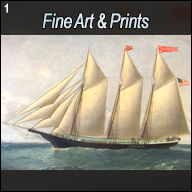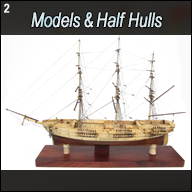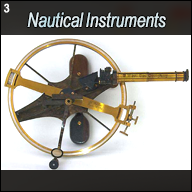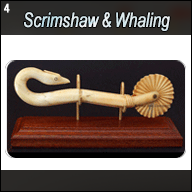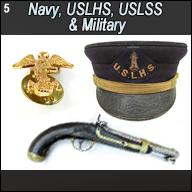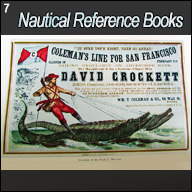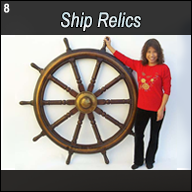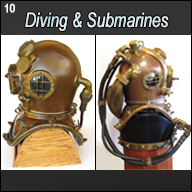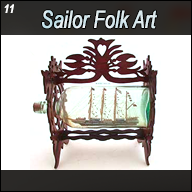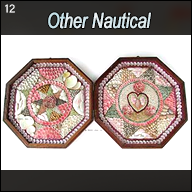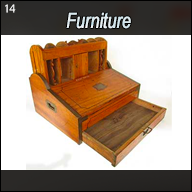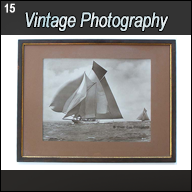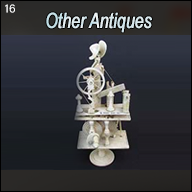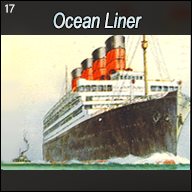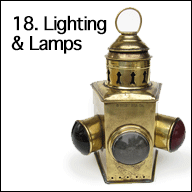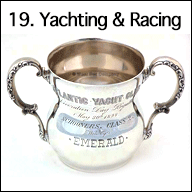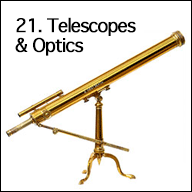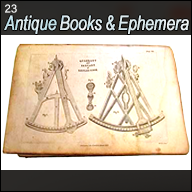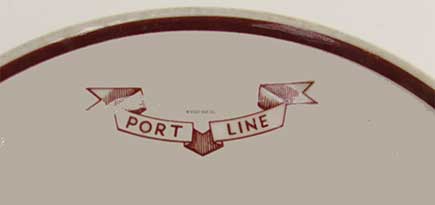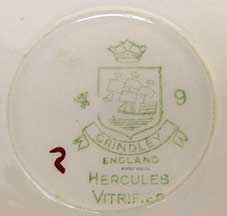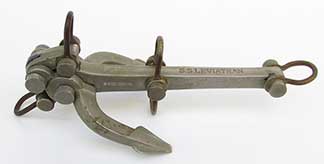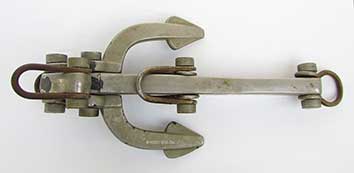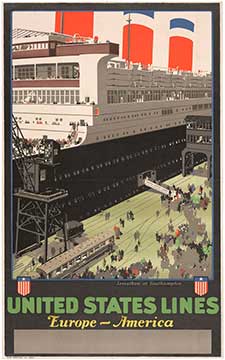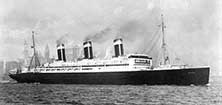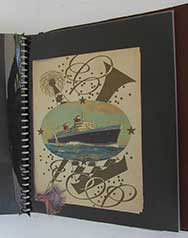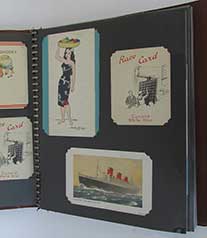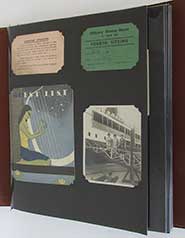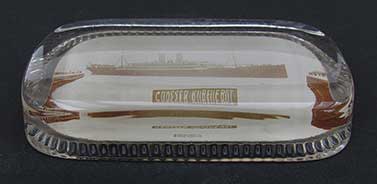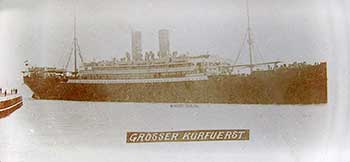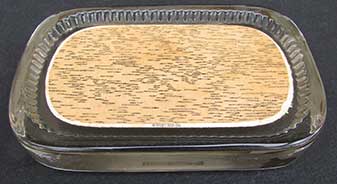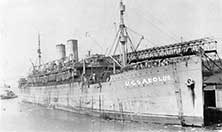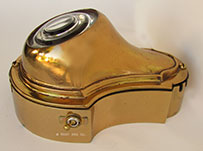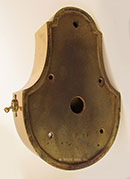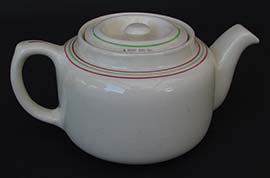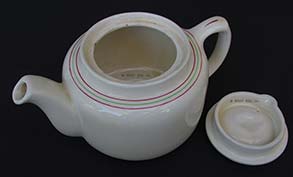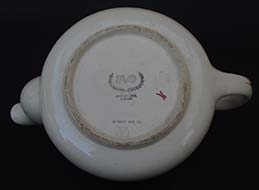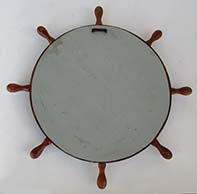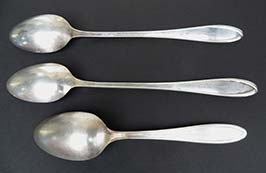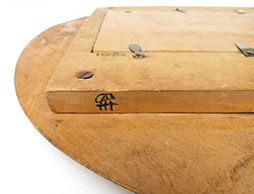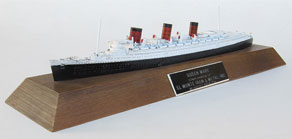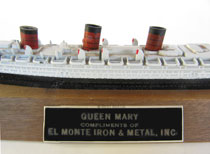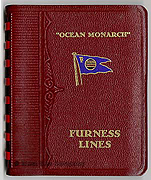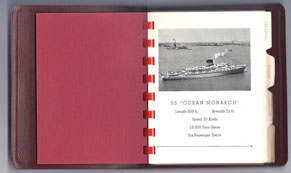17. Ocean Liner
Prices in U.S. Dollars are in GREEN
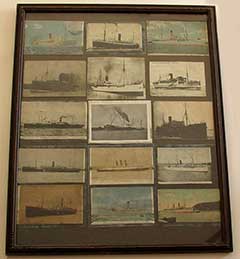 |
17.35 STEAMSHIP COLLAGE. Grouping of 15 postcard size images of early British steamships: LLANSTEPHAN CASTLE. SOPHOCLES, DOVER CASTLE, BERRIMA, RMS COMRIE CASTLE, RMS LLANDOVERY CASTLE, MS SICILIAN, (Freighter), HMT FIELD MARSHAL, BORDA, PRINCE GEORGE, GASCON, RMS HRAWA, CARISBROOK CASTLE and MAILBOAT. Some are actual photographs, some are lithographs and yet others are chromolithographs. All are period images of the ships they represent. Most interestingly 11 of the images overlay what appear to be duplicate or similar images behind them! 18 by 21 ½ inches. Overall condition is very good. However 5 of the images have condition issues, the most serious being that of SOPHOCLES which has 2 tears and a small loss in its upper center. The other issues consist of minor spotting. 10 are excellent. All are housed under glass in their period wooden Art Nouveau frame with original paper backing (spotted with some minor perforations), dating from the early 1900's. Since the framing is original, we have not attempted to break into what might otherwise be a very revealing discovery! WAS $295 NOW! 95 |
 |
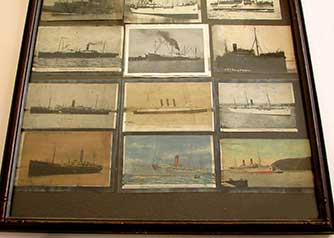 |
| detail top | detail bottom |
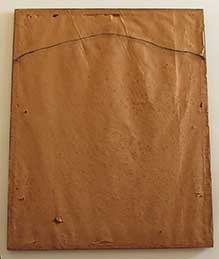 |
| back |
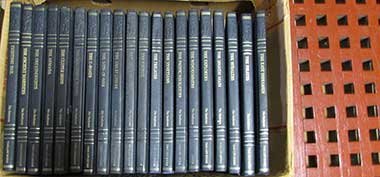 |
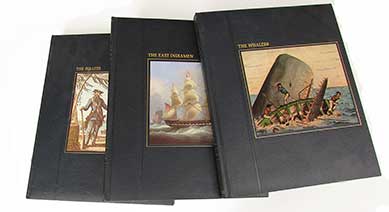 |
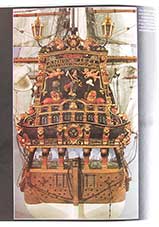 |
| sample covers | plate I |
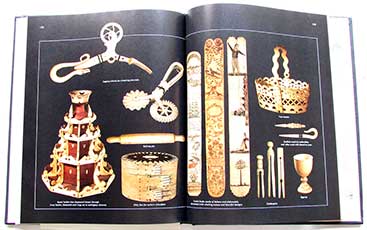 |
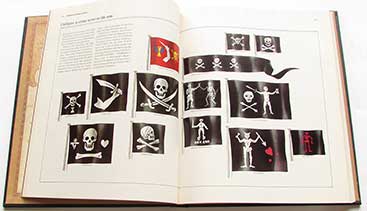 |
| plate II | plate III |
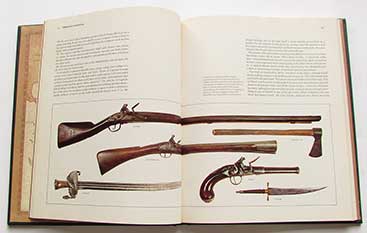 |
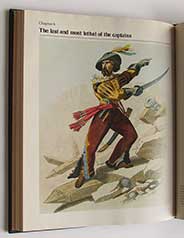 |
| plate IV | plate V |
 |
17.38 FAMOUS LINER HAT RIBBON. Genuine ship’s creman’s hat ribbon from the illustrious French Passenger liner ILE DE FRANCE. This machine embroidered ribbon is made of colorful silk. The French national ensign flies on the left and the CGT house flag is on the right. 27 inches long. Outstanding original condition. The images are crisp and the colors bright. 49 The luxury ocean liner SS ILE DE FRANCE was launched by the Chantiers de Penhoët shipyard in 1927. Outfitted in the Art Deco style, she was built in a partnership between Compagnie Générale Transatlantique (CGT) and the French government. The ship was so popular that by 1935 it had carried more first-class passengers than any other transatlantic liner. In 1939, ILE DE FRANCE and the liner SS NORMANDIE were laid up by CGT to protect the vessels from the threat of German commerce raiders and submarines. In 1940 the French government loaned ILE DE FRANCE to the British Admiralty for the transport of troops and material. When France fell to Germany in 1941 the British seized the ship outright and converted her into a troopship. In that capacity she made several trans-Atlantic crossings until War’s end. In late 1945 she was returned to CGT ownership. In 1947, CGT carried out an extensive refit which spanned a period of two years. The ship’s profile was significantly altered when one of its three funnels was removed and the other two streamlined. The vessel’s accommodations were also changed by removing half of its tourist class berths. After overhaul ILE DE FRANCE returned to passenger service. On the evening of July 25th 1956 one of the worst maritime disasters in modern history occurred when the MS STOCKHOLM struck the SS ANDREA DORIA in dense fog off the coast of Nantucket, Massachusetts. The following day, ILE DE FRANCE, outbound from New York, received an SOS signal from the stricken ANDREA DORIA. Upon receiving the distress call ILE DE FRANCE immediately altered course to assist with rescue operations. On arrival she launched 13 lifeboats and her crew began bringing survivors back to the French liner. By late morning, the crew had rescued 753 survivors, more than any other vessel on the scene. After discharging survivors back in New York she resumed her voyage to Europe. By the late 1950s, ocean travel was in decline as air travel increased in popularity. In the face of waning business CGT sold ILE DE FRANCE to a Japanese ship scrapping company in 1959. She was dismantled later that year. |
 |
 |
| detail | ship |
 |
17.36 FAMOUS LINER SALT. Diminutive, very decorative component of First Class silverware from the famed liner RMSP ALMANZORA as elegantly portrayed on the cloisonné coat of arms applied to the front. This lovely piece has indistinguishable hallmarks on the bottom. It measures 5 inches wide overall, 2 ½ inches in breadth, and 1 7/8 inches high. Outstanding original condition. A beauty! 119 RMSP stands for Royal Mail Steam Packet. RMS ALMANZORA was a 15,551 gross ton liner of the Royal Mail Steamship Line. She was built in Belfast, Ireland in 1912, the same place and year the RMS TITANIC was launched. During World War I she served as a Royal Navy armed merchant cruiser from 1915 until 1920. Returning to civilian service in 1920, she was scrapped in 1938. |
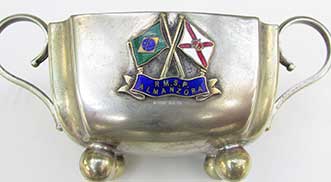 |
 |
| detail | bottom |
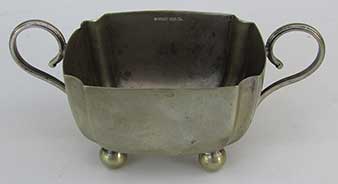 |
 |
| back | ship |

|
detail top |
detail bottom |
back |
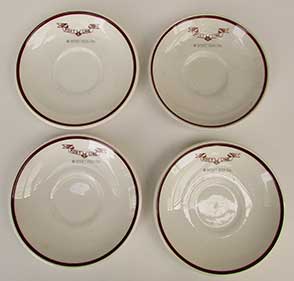
|
17.33 "PORT LINE" SAUCERS. Matched set of 4 hard fired porcelain saucers bearing the emblem of the "PORT LINE" shipping company on a streaming banner. Three have the maker's mark of a unicorn reading "VITRILAINE WEDGEWOOD TUNSTALL LTD. ENGLAND TRADEMARK. The bottom of the fourth bears the maker's mark of a sailing ship within a shield surmounted by a crown, flanked by the numbers "4 9" below which is a banner reading "GRIDLEY." It is also marked "ENGLAND HERCULES VITRIFIED." 5 ½ inches in diameter. All are in perfect original condition. 70+ years old from the age of steam! 89/set |
port line |
maker |

|
17.31 IDENTIFIED MINIATURE ANCHOR. Quite scarce exact period replica of one of the anchor from the famous liner LEVIATHAN as marked on the shank "S.S. LEVIATAHN." This little anchor, faithful to the original, is made of heavy nickel silver and brass. It fully articulates at 5 points along its length which is 6 inches. This type of stockless anchor is more properly referred to as a modified "Klip" or "Hall." It is 2 ¾ inches wide on the flukes and has a total of 5 pivoting shackles affixed in a very realistic manner. Excellent original condition. Approximately 100 years old. 269 |
perspective |
reverse |
side |
plate |
ship 1 |
ship 2 |

|
17.29 IMPORTANT OCEAN LINER CRUISE BOOK. Large, fully leather-bound compilation of an amazing variety of passenger liner memorabilia amassed over a period of 40 years from the 1920's into the 1960's during the Golden Age of steamship travel! This binder contains 32 pages of menus, passenger lists, photographs, post cards, life boat instructions, promotions, tickets, passes, maps, pamphlets, labels, coasters, clippings and more. Many pages have multiple entries. The lines represented are Matson, Cunard White Star (QUEEN MARY), Norwegian Caribbean Lines, United States lines, N.Y.K. Line, Hamburg America Line, Pacific Mail Steamship Line, North German Lloyd and Norddeutsher Lloyd. ALL contents are in perfect original condition preserved under heavy plastic covers. This handsome presentation measures 13 by 14 1/2 inches and is 2 inches thick. A simply outstanding original collection! Also included are two handsome pennants from the N.Y.K. Line. 249 |
plate 1 |
plate 2 |
plate 3 |
plate 4 |
plate 5 |

|
17.28 OCEAN LINER COMMEMORATIVE. Very early 1900's ornate glass paperweight from the famous German passenger liner S.S. GROSSER KURFUERST." This authentic relic was no doubt purchased by a passenger as a souvenir for their voyage on the impressive liner. It features a genuine albumen photograph of the ship taken from a starboard side view. A number of spectators can be seen standing on the quays on either side as the ship enters port. The image is entitled "GROSSER KURFUERST" lower center. It is mounted under a ¾ inch thick scalloped glass weight measuring 4 by 2 ½ inches. Outstanding original condition in all respects. 99 |
perspective |
detail |
bottom |
ship |
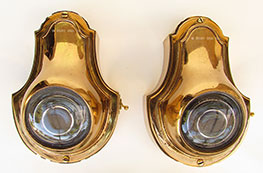
|
17.27/18.98 OCEAN LINER BUNK LAMPS. Exceptional matched pair of 1st Class Cabin bunk lamps retrieved from an English passenger liner during the Golden Age of liner travel. These classic Art Deco lamps are pleasingly cast in “tear drop” form in solid bronze! The extremely heavy bodies house the thick ribbed Fresnel glass lenses which focused the light for the reader. The tops and bottoms of the lamp bodies are vented to prevent overheating. Each is professionally wired for standard 110v American service. The old fashioned style toggle switches are brand new, UL approved, ready for hook-up. These lamps will accommodate a 60W or smaller incandescent or similar size LED bulb. 7 ¾ inches high by 5 3/8 inches wide and 4 ¼ inches deep, weighing an amazing 6 1/2 pounds each! Pristine original condition with an old high luster polish. Ready to use. Circa 1930. 595/pr |
side |
back |
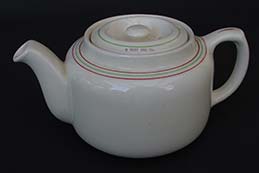
|
17. 25 OCEAN LINER TEAPOT. Original teapot used in the service of the P & O Lines in the liner heyday of the 1950’s. This pristine example is hard fired porcelain complete with vented top which has a lip to prevent the top from slipping while pouring. The bottom is marked “P & O Ashworth Bros., England” inside a floral wreath with two hand-painted red marks. It is also impressed with the number “30” on the lower rim. 7 ¼ inches across including the spout and handle. 4 5/8 inches in diameter overall. Perfect original condition. 59 |
reverse |
open |
maker |

|
17.24 FAMOUS LINER COMMEMORATIVE. Very early 1900’s West Coast ship’s memento depicting the well known passenger liner MATSONIA underway at sea as seen from a port bow perspective. This original early albumen image in sepia tones bears scrutiny under magnification. Deck details, crewmen and the ship’s structure are clearly depicted. The faint image of another ship can be seen on the far right horizon. This period photograph is housed under its original old wavy glass in a sculpted redwood frame with 8 spokes denoting a ship’s wheel. It is hand-painted “M. N. Co. MATSONIA” in a distinctive style which bears further research as to the origins of this California cottage industry maker from 1905 onward. 12 inches wide from spoke to spoke. The body of the presentation is 9 inches in diameter, and the image itself is 5 ½ inches in diameter. Magnificent, untouched original condition. A very desirable West Coast offering, over 100 years old! 299 The passenger liner SS MATSONIA was built by the Newport News Ship Building Company, Newport News, Virginia and launched, in 1913 for the Matson Steam Navigation Company. The Matson fleet was based out of Hawaii, so MATSONIA began her early career in the Pacific running between the mainland U.S, Hawaii and Far East destinations. As war clouds developed in Europe, she was acquired by the U.S. Shipping Board and turned over to the Navy at New York (by way of the Panama Canal), in January 1918 as a troop ship. She was commissioned USS MATSONIA on March 1, 1918. The unique form of this presentation appears to have been done in the very early 1900’s by an individual or small workshop based in central California. The distinctive lettering and the exclusive use of redwood are signatures of this folk art form. In our tenure we have encountered at least 5 nearly identical examples, all dating from 1905 to 1920. If anyone can shed more light on their origin, we would be very interested to learn of it. |
image |
back |
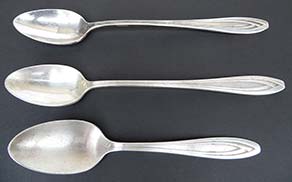
|
17.21 LINER SILVERWARE. Lot of three passenger liner spoons marked “Moore- McCormack Lines” on the backs of the handles and further marked “International Silver Co.” on the stems. Bargain priced. All three for one money. 15 |
back |
marks |
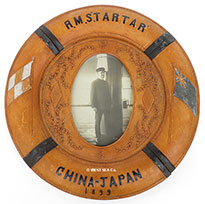
|
17.15 EARLY LINER COMMEMORATIVE. Exquisitely-carved late 19th century China trade ship memento in the form of a life preserver frame. This scarce example bears painted raised letters reading “R.M.S. `TARTAR’ CHINA-JAPAN 1899.” It is flanked on the left by the house flag of the Canadian-Pacific Line and on the right by the British ensign. The inside of the ring has a very intricate rope-carved border encircling delicate floral vines with amazing detail backed by tiny stippling. In its center is the oval-framed period photograph under the original old wavy glass of the ship’s captain standing on the wooden deck next to the mainmast. The reverse of this presentation has its original backing and is signed by the carver in two places with a single character mark – one in pencil and the other painted. 11 inches in diameter and in virtually perfect original old condition. 499 |
LEFT DETAIL |
DETAIL |
RIGHT DETAIL |
BACK |
SIGNATURE |
17.13 OCEAN LINER MODEL. Period miniature commemorative of the famous ocean going liner the RMS QUEEN MARY. This detailed model is faithfully cast out of metal in high relief depicting the major details of the ship including funnels, ventilators, deck equipment and lifeboats. In was then hand painted in red, white and black to accentuate those details. It is mounted on a solid hardwood plinth bearing the engraved presentation plaque reading “QUEEN MARY Compliments of El Monte Iron & Metal, Inc.” The entire presentation measures nearly 1 foot long by 3 inches wide. The ship itself measures just over 10 inches long. Excellent original condition. A very nice presentation for desk or library shelf. 179 Construction of the ship known only as "Yard Number 534", began on December 19, 1930 by the John Brown Shipbuilding Company in Clydebank, Scotland. Under ownership of the Cunard Lines the ship was ultimately launched 3 ½ years later with the name QUEEN MARY on September 26,1934. Named after Queen Mary, the consort of King George V, her name was a closely guarded secret up until her launch. RMS QUEEN MARY sailed on her maiden voyage from Southampton on May 27, 1936. In August of that year she captured the Blue Riband for Atlantic crossings from her rival the lovely French liner NORMANDIE, with average speeds of 30.1 knots westbound and 30.6 knots eastbound. She retained the prize until 1952 when the SS UNITED STATES surpassed those speeds. Early in September 1939 QUEEN MARY steamed out of Southampton for New York. But by the time she arrived war in Europe had erupted and she was ordered to remain in port until further notice alongside the NORMANDIE. In 1940 QUEEN MARY and NORMANDIE were joined by QUEEN MARY’s new sister ship, QUEEN ELIZBETH, fresh from her secret dash from the Clydebank. There, the three largest liners in the world sat idle for some time until the Allied commanders decided that they should be used as troopships. QUEEN MARY departed for Sydney, Australia where she and several other liners were converted into troopships. Eventually joined by QUEEN ELIZABETH, they were the largest and fastest troopships involved in the war, often carrying as many as 15,000 men on a single voyage. On October 2, 1942, QUEEN MARY sank one of her escorts, cutting through the light cruiser HMS CURACOA off the Irish coast. Due to the ever present threat of U-Boat attacks, her captain was under strict orders not to stop for any reason. So the remaining Naval escorts in company were ordered to rescue survivors. As a result the accident cost 338 lives. During the war, the QUEEN MARY carried British Prime Minister Sir Winston Churchill several times. On those voyages the Prime Minister insisted on having his lifeboat equipped with a machine gun in order to "resist capture at all costs". After the war QUEEN MARY was refitted for passenger service, which she resumed in 1947. QUEEN MARY and QUEEN ELIZABETH continued to dominate the transatlantic passenger trade well into the 1950s. But when transatlantic passenger jet service began in 1958 the golden era of the “Cunard Queens” came to an end. Beset by age, inefficiency and public apathy, Cunard was finally forced to remove the grand liners from service. QUEEN MARY was retired in 1967 and QUEEN ELIZABETH was withdrawn in 1968. Ultimately the city of Long Beach, California outbid Japanese scrap merchants and QUEEN MARY was saved. Hoping for a similar fate a team of investors purchased QUEEN ELIZABETH for an attraction in Port Everglades, Florida. However the venture did not work out and she was sold to a Hong Kong businessman. Unfortunately before she could be fully restored she caught fire and sank in 1972. |
17.62 CRUISE BOOKLET. Original mid-1900’s booklet provided to passengers of the S.S. OCEAN MONARCH of the Furness Lines. This cruise memento is bound in faux leather and opens to the tile page depicting the OCEAN MONARCH steaming in New York Harbor with the Statue of Liberty in the background. It states ‘S.S. OCEAN MONARCH Length 509 ft. Breadth 72 ft. Speed 20 knots, 15,000 Tons Gross, Six Passenger Decks.” The booklet is then divided into sections with tabs marked “ITENERARY, PEOPLE, RECORDS, PHOTOGRAPHS.” Unmarked except for a single page. 4 ½ by 5 ¼ inches. Outstanding original condition. 29 |
OPEN |
17.83 FAMOUS SHIP'S LIFERING. Authentic ship's life ring from one of the most famous passenger liners in history, the French Line's SS LIBERTÉ as boldly stenciled on the top front. This classic lifering is of standard old world construction having a solid cork core overlaid by heavy hand-stitched sail canvas and rimmed with a hemp rope grab line. The back of the ring is stamped "Bouee 75 Liege Homologation 55 ES Anciens Etd., Labbe, Nantse." 29 inches in diameter. Excellent original condition showing a few scuff marks and a couple of small holes in the fabric, as expected. The SS EUROPA (renamed SS LIBERTÉ ) was one of two fast ocean liners built by Blohm & Voss shipyard, Hamburg, Germany in the late 1920's for the Norddeutscher Lloyd Line (NDL) to ply the transatlantic passenger service. EUROPA was launched August 1, 1928 and made her maiden voyage to New York on March 19, 1930. She was a vessel of 936.7 feet in length displacing 49,746 gross tons. Her four steam turbines generated 105,000 shaft horse power propelling her to a speed of 27 1/2 knots. She had a passenger capacity of 860 first class, 500 second class, 305 tourist class, 617 third class and a total crew of 965. During the early years of World War II EUROPA, in German hands, was largely inactive. She was captured by the Allies in 1944 and subsequently pressed into service as a troopship. After the war she was turned over to the French as a reparation of war. In 1946, while being refitted for passenger service in Le Harve, France, she snapped her moorings during a storm, drifted into the wreck of the PARIS and sank. She was refloated and work continued. In 1950 she made her maiden voyage to New York under her new name, SS LIBERTÉ. After nearly 10 years of service she was finally retired in 1958, laid up in 1961 and scrapped in 1962. |
17.92 GLASS ASHTRAY. Thick molded glass ashtray with the boldly stenciled name "CUNARD" on the bottom. 6 inches in diameter and 1 1/4 inches thick. Perfect condition. 59
The famous Cunard Line can trace its history all the way back to 1838 when shipping magnate Samual Cunard and others formed the British and North American Royal Mail Steam Packet Company. Cunard faced many competitors from Britain, France, the United States and Germany, but survived them all. This was mainly due to a great focus on safety. Cunard ships were not the largest nor the fastest but they earned a reputation for being the most reliable and the safest. The prosperous company eventually absorbed Cunard's principal competitor, the White Star Line, owners of the ill-fated RMS TITANIC and the HMHS BRITANNIC.
For more than a century and a half, Cunard dominated the Atlantic passenger trade and was one of the world's most important companies, with the majority of their liners being built at the John Brown Shipyard in Clydebank, Scotland. Today the Line still operates two classic passenger liners the RMS QUEEN ELIZABETH II and the RMS QUEEN MARY II.
17.87 PORCELAIN ASHTRAY. Hard fired porcelain ashtry bearing the logo NAC (Norwegain-American Cruise Lines). This diminutive ashtray has 18 raised nibs on its periphery to hold cigarettes. The bottom is signed and dated "Porsgrund, Norway 1980" with an anchor. 3 12/ inches in diameter. Perfect condition. 39
The company was founded as Norwegian Caribbean Lines in 1966 by Knut Kloster and Ted Arison with just one 830-ton cruise ship offering low cost Carribean cruises. Arison soon left to form Carnival Cruise Lines, while Kloster acquired additional ships for Caribbean service. NCL pioneered many firsts in the cruise industry and was responsible for many of the cruise innovations that have now become standard throughout the industry.
NCL made headlines with the acquisition of the FRANCE in 1979, rebuilding the liner as a cruise ship and renaming her NORWAY. At that time the NORWAY was significantly bigger than any other cruise ship, and exploited the extra space available by adding a large variety of onboard entertainment. Her success paved the way for a new era of giant cruise ships.

|
17.70 CRUISE TROPHY. High quality, silverplate loving cup with applied, high relief brass emblem reading "Awarded on Holland-America Line Cruises" depicting the line's house flag. This handsome cruise memento is said to have come from the famous pre-War liner NIEUW AMSTERDAM. It stands 6 1/2 inches tall and slightly more than 5 1/2 inches wide. Excellent original condition. 195
The Nederlands-Amerikaansche Stoomvaart-Maatschappij, popularly known as the Holland-American Line, was founded in 1873 and based in Rotterdam, The Netherlands. Neutral registry in World War I brought large profits to the company and it was in a position to expand. However American immigration restrictions following the War delayed construction of the company's flagship the NIEUW AMSTERDAM until 1938. When the Germans invaded Holland in May of 1940, they seized the OLENDAM while the STATEMDAM was destroyed in the fighting. The remainder of the company's fleet was chartered by the Allies for the war effort. The NIEUW AMESTERDAM in particular had a spectacular war career, performing troop carrying duties throughout the world until her triumphant return to her home port in April 1946.


